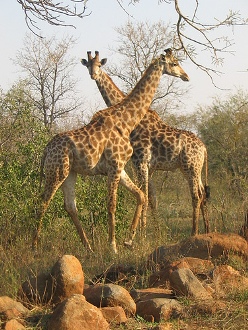Kruger National Park
 Located right in the heart of Lowveld region, Kruger National Park, the largest game reserve in South Africa, is a unique wildlife sanctuary offering unique experiences to all those who enter the park.
Located right in the heart of Lowveld region, Kruger National Park, the largest game reserve in South Africa, is a unique wildlife sanctuary offering unique experiences to all those who enter the park.
Location
Kruger National Park stretches over two South African provinces: Mpumalanga and Limpopo, in the north part of the country. To the north it borders Zimbabwe and to the east Mozambique.
Now it’s part of the Great Limpopo Transfrontier Park, which links Kruger to game parks in the two bordering countries. When completed, the new park will extend across 35,000 sq km / 13,513 sq miles, of which over 50% in South Africa.
How to get to Kruger
If you choose to fly you can take a domestic flight either to Phalaborwa Airport, Hoedspruit Airport or the new Kruger/Mpumalanga International Airport (KMIA). Cape Town and Durban are very well linked to these airports.
From KMIA there are private shuttles available. The journey takes an hour and 20 minutes and costs Rand 500 (ZAR) per person. It’s very important to book the seats in advance.
Travelers can also rent a car at the airport for about $42/Rand 300 per day.
The Wildlife
Kruger, the most important national park in South Africa, is home to 147 mammals, 507 birds, 49 fish, 114 reptiles, 34 amphibians and 336 trees, making the park the most biodiverse Game Reserve on Earth.
Kruger National Park is divided into six ecosystems:
- Baobab sandveld
- Mopane scrub
- Lebombo knobthorn-marula bushveld
- mixed acacia thicket
- Combretum-silver clusterleaf woodland on granite
- riverine forest.
All the Big Five –Lion, African Elephant, African Buffalo, Black Rhinoceros, Leopard- are found at Kruger.
There are four regions which make it easier for the traveler to plan their drive:
- Central Region: comprises about 30% of the park’s area and is home to the lions. Also you will be able to see cheetahs, leopards and hyena here, as well as the herbivores: antelopes, giraffes, wildebeests and zebras.
- Far North Region: it’s a lot different than the other regions of the park and home to the beautiful birds and fish. This is the only region where you can see the Natal red hare and yellow-spotted rock dassie. Along the banks of the Luvuvhu River there are numerous forests and picnic sites.
- Northern Region: it’s a semi-arid area which sees little rain. However, a lot of rivers make their away across this land. Here you will find about 60% of the park’s hippo population and the accompanying birds. Also along the Luvuvhu River you will find the elephants, buffalos, impalas, waterbuck, bushbuck, all concentrated near the water supplies.
- Southern Region: is a wonderful area where you will find the leopard, baboons, giraffes, zebra, buffalos, elephants and klipspringers.
Activities
 Professional and armed guides will take you on tours. You can bike, hike, walk or drive.
Professional and armed guides will take you on tours. You can bike, hike, walk or drive.
If you prefer to drive, choose among the four adventure trails available: Madlabantu, Mananga, Nonokani and Northern Plains.
If you prefer to walk and camp in the wild, there are 7 wilderness trails in Kruger Park. The Back Pack trail is aimed at the more adventurous travelers. Participants must bring their own tents and necessary supplies. The adventure extends over 4 days and 3 nights.
Also there are guided walks available. A group of maximum 8 people are guided in the bushes by an armed ranger. These tours leave from all the camp sites and booking in advance is needed. Children under 13 are not allowed on such walks.
More details about the trails can be found on Kruger’s official site.
Facilities and Accommodation
Kruger is a self-drive destination and it’s easy to plan a do-it-yourself safari, although guided tours are available. The infrastructure is incredible, including rest camps, picnic sites and waterholes.
When you want to book a room, first check what types of accommodations are available at the cam site you want to stay.
There are 9 types of accommodation available around the park:
- Campsites: both for caravans and tents, most have power and water taps
- Huts: are single room units with access to shared kitchen and bathroom
- Safari Tents: are permanent tents located on platforms; some are rudimentary while some are quite luxurious
- Bungalows: are single bedroom units with bathrooms. Some have shared kitchen while others have their own small kitchen.
- Cottages: are single bedroom units with living room, bathroom and kitchen.
- Family Cottages: are multiple bedroom units with living room, bathroom and kitchen.
- Guest Cottages: are multiple bedroom units, with at least 2 bathrooms and kitchen.
- Guest Houses: are multiple bedroom units, with lounge area and bar facility, offering a great view
- Bush Lodges: are private lodges with multiple rooms and bathrooms.
Live Webcams
If you want to see what’s happening at Kruger, you can visit the official website and look at one of the three webcams.